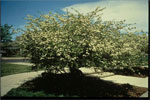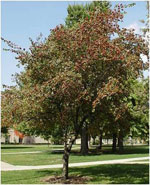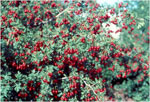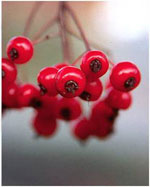Thornless Cockspur Hawthorn ( Crataegus crusgalli inermis), Russian Hawthorn (Crataegus ambigua), and Washington Hawthorn (Crataegus phaenopyrum) are all planted in Front Range landscapes. All are considered small trees to about 20-25 feet at maturity, although Washington Hawthorn is sometimes grown as a large, multi-stemmed shrub. All have reddish buds in the dormant season. All have alternate leaves and attractive white flowers in late spring/early summer. Following are some differences:
Leaf shape
 Thornless Cockspur Hawthorn – leathery, serrated, unlobed, spoon-shaped, borne on short petioles
Thornless Cockspur Hawthorn – leathery, serrated, unlobed, spoon-shaped, borne on short petioles- Russian Hawthorn – 5-7 deep lobes, triangular overall shape, on long petioles
- Washington Hawthorn – 3-5 shallow lobes, triangular overall shape, on long petioles
Leaf color
- Thornless
 Cockspur Hawthorn – glossy dark green to yellow, bronze and purplish in fall
Cockspur Hawthorn – glossy dark green to yellow, bronze and purplish in fall - Russian Hawthorn – medium green to yellow, bronze and purplish in fall
- Washington Hawthorn – dark green to orange-red-purple in fall
Flowers
- Thornless Cockspur Hawthorn – May-late May, malodorous
- Russian Hawthorn – late May-June
- Washington Hawthorn – June
Fruit
- Thornless Cockspur Hawthorn – dull red-purple, 1/8”, persisting into fall/winter
- Russian Hawthorn – attractive dark red-purple, 1/2”, persisting into late fall

- Washington Hawthorn – attractive glossy red-orange, ¼”, persisting into winter
Thorns
- Thornless Cockspur Hawthorn – none
- Russian Hawthorn – sparse, shorter (3/8”)

- Washington Hawthorn – numerous, longer (1.5-2”)
Hawthorn mealybug occurrence
- Thornless Cockspur Hawthorn – very prone
- Russian Hawthorn – less prone
- Washington Hawthorn – rarely infested



